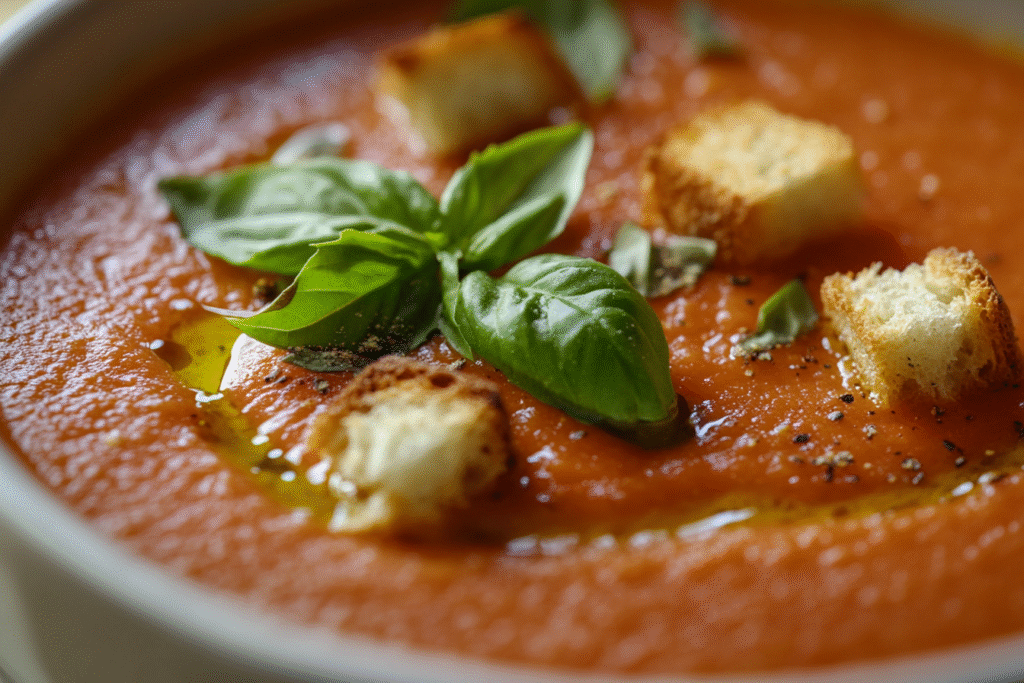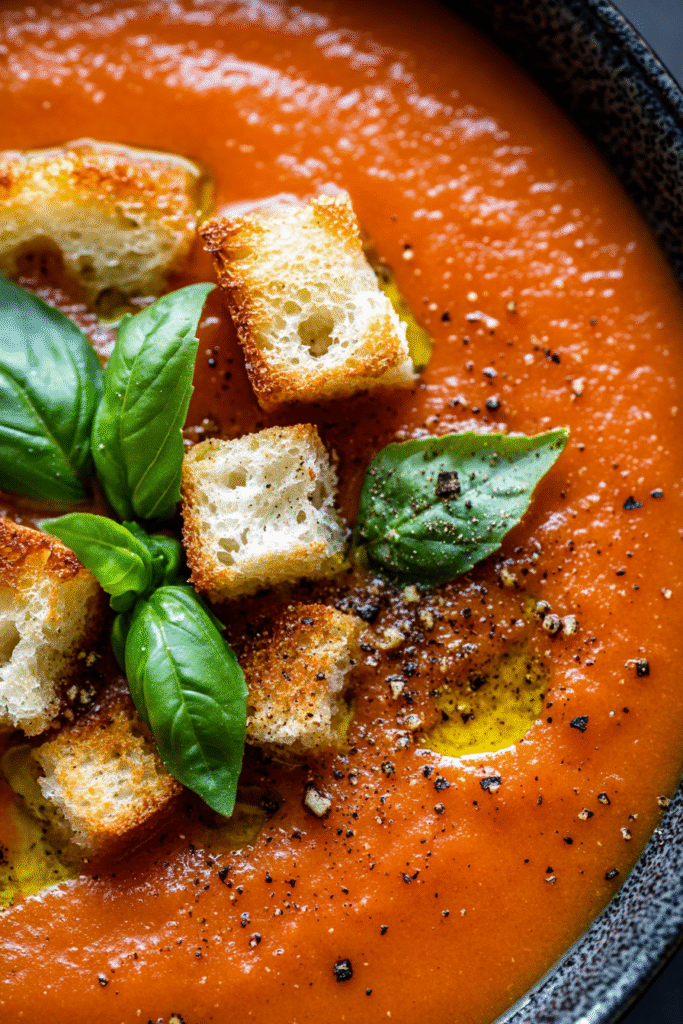There are few dishes as universally comforting as a bowl of Creamy Roasted Tomato Soup. Unlike the overly sweet, sometimes bland versions found in cans, this homemade soup is rich, deeply flavorful, and layered with the caramelized sweetness of slow-roasted tomatoes. Roasting the tomatoes intensifies their natural flavors, bringing out a subtle smokiness and a beautiful depth that’s perfectly balanced by the silkiness of cream.
This soup is incredibly versatile—it can be the star of a cozy dinner, the ideal pairing for a gooey grilled cheese, or a sophisticated starter for a more elevated meal. With its velvety texture, slightly tangy bite, and touch of sweetness, this soup hits all the right notes.
Why You’ll Love Creamy Roasted Tomato Soup
This isn’t just another tomato soup. It’s richer, more complex, and full of concentrated tomato flavor.
What makes this recipe a must-make:
- Roasting the tomatoes brings a natural sweetness and smoky depth that stovetop-only versions lack.
- The soup is smooth and creamy but not heavy.
- It pairs beautifully with simple sides like crusty bread or grilled cheese.
- It’s easy to make ahead and freezes well for future meals.
- Customizable with various herbs, spices, and toppings.
Once you try roasting your tomatoes for soup, you may never go back to the standard approach.

Choosing the Best Ingredients for Maximum Flavor
For a soup with so few ingredients, quality is critical. Each component plays a big role in the final flavor.
Tomatoes
The heart of this soup. Look for:
- Roma or plum tomatoes: Their low water content and natural sweetness make them ideal for roasting.
- Heirloom tomatoes: Excellent for summer; they bring complexity and subtle variations in flavor.
- Cherry tomatoes: If you want extra sweetness, adding a few to the roasting tray can brighten the soup.
If fresh tomatoes are out of season, high-quality canned San Marzano tomatoes can substitute, though fresh is always best for roasting.
Garlic
Roasting garlic alongside the tomatoes adds a mellow, nutty flavor that’s irreplaceable. Whole cloves roasted in their skins prevent burning and deliver a soft, sweet garlic note.
Onion
Provides a savory base. Sweet onions or yellow onions both work well.
Olive Oil
A good extra-virgin olive oil is essential for roasting and finishing. It contributes richness and balances acidity.
Cream
Heavy cream gives the soup its silky finish. Half-and-half can be used for a lighter version, or coconut milk for a dairy-free twist.

Recommended Equipment for This Recipe
- Baking sheet: For roasting the tomatoes, garlic, and onions.
- Blender or immersion blender: For a smooth, creamy texture.
- Large saucepan or Dutch oven: To finish the soup on the stovetop.
- Fine mesh strainer (optional): For extra smoothness if desired.
Common Pitfalls and How to Avoid Them
1. Soup too acidic:
Tomatoes can vary in acidity. Roasting naturally sweetens them, but if the soup tastes too sharp, stir in a little honey, sugar, or cream to balance it.
2. Burnt garlic:
Garlic burns easily during roasting. Leave the cloves in their skins to protect them, or wrap them loosely in foil on the baking tray.
3. Soup too thin:
This can happen if the tomatoes release a lot of water during roasting. Simmer the blended soup uncovered to thicken, or add a small spoonful of tomato paste to concentrate the flavor.
4. Soup too bland:
Don’t be shy with salt and seasoning. A splash of balsamic vinegar, a drizzle of good olive oil, or a sprinkle of Parmesan can revive a flat-tasting soup.
Flavor Enhancements and Creative Variations
- Add fresh basil: Blend in a handful of basil for a classic tomato-basil flavor.
- Roast with red bell peppers: Adds natural sweetness and a subtle smoky note.
- Spice it up: Add crushed red pepper flakes or a drizzle of chili oil.
- Incorporate Parmesan rind: Simmer with the soup to add depth, then remove before blending.
- Finish with balsamic glaze: Adds acidity and complexity.
Smart Preparation Strategies
- Make ahead: The soup can be made up to 3 days in advance and reheated gently.
- Batch cooking: Perfect for doubling and freezing. Store in individual portions for easy weekday lunches.
- Roast extra vegetables: You can roast additional garlic, onions, or even carrots on the same tray for added sweetness and body.
Substitution Guide for Dietary Needs
- Vegan: Use coconut milk or unsweetened cashew cream instead of dairy cream.
- Gluten-free: Naturally gluten-free.
- Low-carb: No adjustments needed; this soup is naturally low in carbs.
- Nut-free: Safe as written.
Ingredients
For Roasting
- 2 ½ pounds Roma or plum tomatoes, halved
- 1 large yellow onion, quartered
- 6 garlic cloves, unpeeled
- 3 tablespoons olive oil
- 1 teaspoon salt
- ½ teaspoon freshly ground black pepper
For the Soup
- 3 cups vegetable broth
- ½ cup heavy cream (or coconut milk for dairy-free)
- 1 tablespoon balsamic vinegar (optional, for brightness)
- ½ teaspoon sugar or honey (optional, to balance acidity)
- Additional salt and pepper to taste
Optional Garnishes
- Fresh basil leaves
- Drizzle of olive oil or chili oil
- Croutons or toasted sourdough
- Parmesan cheese or plant-based alternative
- Balsamic glaze
Instructions
Step 1: Roast the Vegetables
Preheat the oven to 425°F (220°C). Arrange the halved tomatoes, quartered onion, and unpeeled garlic cloves on a large baking sheet. Drizzle with olive oil, sprinkle with salt and pepper, and toss to coat.
Roast for 30-35 minutes, stirring once, until the tomatoes are caramelized and the garlic is softened.
Step 2: Prepare the Soup Base
Remove the garlic cloves from their skins and transfer the roasted vegetables to a large saucepan or Dutch oven. Add the vegetable broth and bring to a gentle simmer over medium heat for 5-10 minutes to blend the flavors.
Step 3: Blend the Soup
Use an immersion blender to puree the soup until smooth. Alternatively, transfer the mixture to a blender and blend carefully in batches. Always vent the lid slightly to release steam.
Step 4: Add Cream and Adjust Flavor
Return the blended soup to the pot (if needed) and stir in the heavy cream. Add balsamic vinegar and sugar or honey if using. Taste and adjust seasoning with additional salt and pepper.
Simmer gently for another 5 minutes to heat through.
Step 5: Serve
Ladle the soup into bowls and garnish with fresh basil, a drizzle of olive oil or chili oil, and croutons or Parmesan if desired.
Serving Suggestions
- Serve alongside a classic grilled cheese or focaccia.
- Pair with a crisp green salad for a light lunch.
- Offer with a side of roasted vegetables or chickpea salad for a heartier meal.
Troubleshooting
- Soup too thick: Add more vegetable broth to thin as needed.
- Soup too acidic: Stir in a touch of sugar, honey, or extra cream.
- Soup tastes flat: Finish with a drizzle of good-quality olive oil, balsamic glaze, or a sprinkle of Parmesan.
Storage and Reheating
- Refrigeration: Store in an airtight container in the fridge for up to 3 days. The soup will thicken slightly when chilled.
- Freezing: Freeze in individual portions for up to 3 months. Thaw overnight in the refrigerator.
- Reheating: Reheat gently on the stovetop over medium-low heat, stirring frequently. Add broth if the soup is too thick after thawing.
Variations: Creamy Roasted Tomato Soup vs. Classic Tomato Soup vs. Tomato Bisque
- Creamy Roasted Tomato Soup: Focuses on roasted tomatoes for depth, with cream for silkiness. Smooth, rich, and full of roasted flavor.
- Classic Tomato Soup: Often stovetop-only, lighter, and sometimes thinner in texture. Can be more acidic if not balanced well.
- Tomato Bisque: Typically heavier and more cream-based, sometimes thickened with flour or butter for a more luxurious, velvety texture.
This Creamy Roasted Tomato Soup finds the perfect balance—it’s creamy without being heavy, deeply flavored without being complicated, and endlessly adaptable to your taste and pantry. Once you master this version, it just might become your year-round comfort soup.


